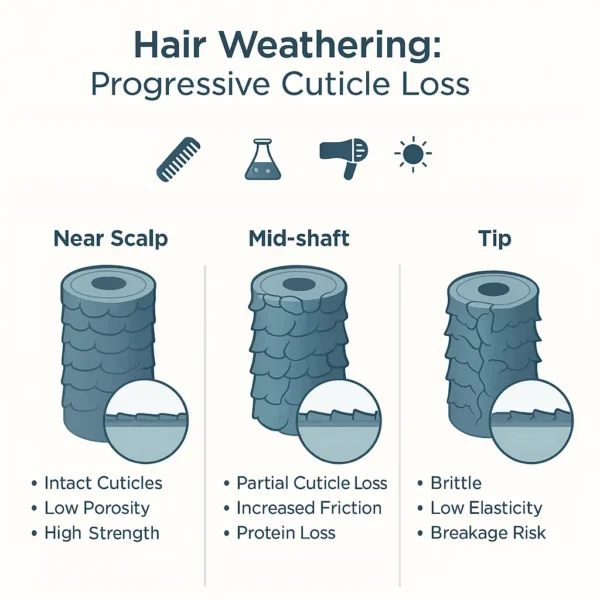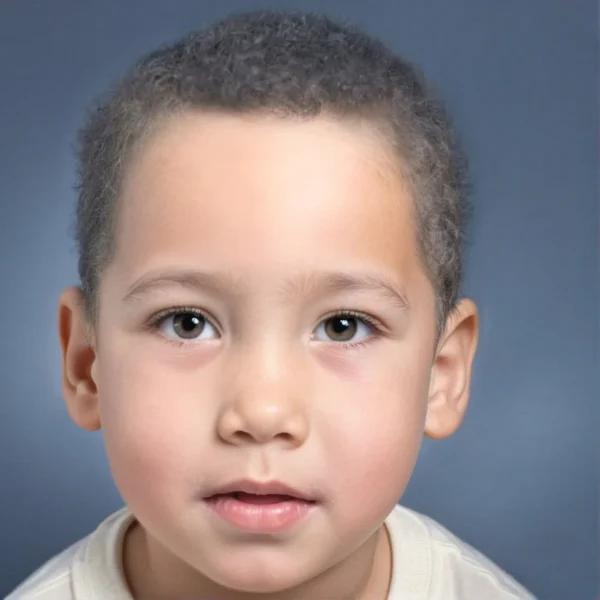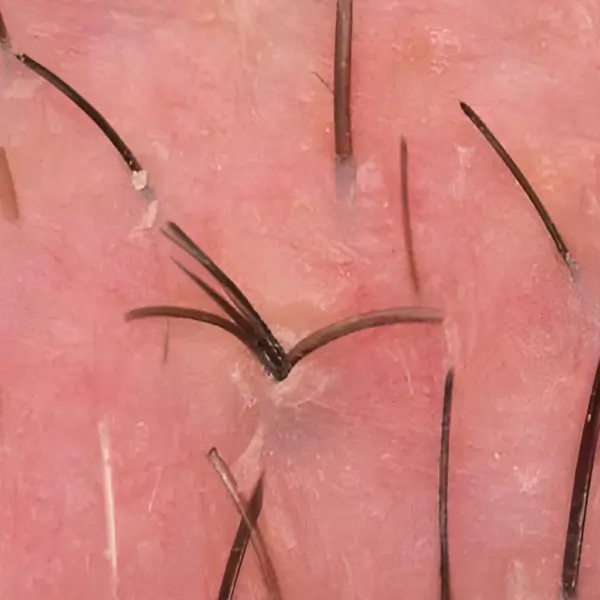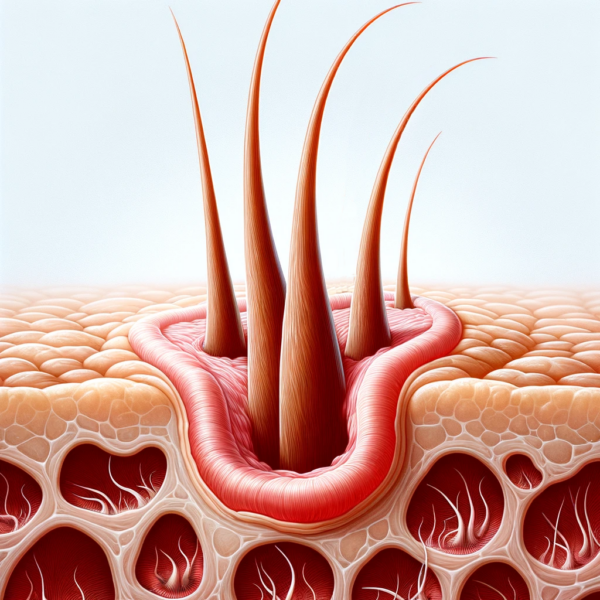Hair weathering refers to the progressive chemical or physical deterioration of the hair shaft, leading to the loss of structural components and increased susceptibility to breakage. This degradation can be caused by a variety of factors, including cosmetic treatments, daily grooming habits, and environmental exposures. The process compromises the hair’s protective cuticle layer, weakens the cortex, and impairs its ability to retain moisture, ultimately impacting both the appearance and mechanical integrity of the hair.
The severity of weathering varies greatly between individuals, depending on genetic factors, hair type, and lifestyle. In general, the older the hair shaft the further from the scalp it is, and the more cumulative damage it exhibits, making long hair particularly prone to deterioration.
Structural Basis of Hair Weathering: A healthy hair fiber is composed of three main layers: the medulla (central core, often absent in fine hair), the cortex (rich in keratin and melanin, providing strength and color), and the cuticle (overlapping cells that protect the cortex). In weathered hair, the cuticle is progressively eroded or stripped away, exposing the cortex to external insults. The cortex then loses tensile strength, elasticity, and pigment, while the hair’s surface becomes rough and dull.
Scanning electron microscopy (SEM) studies have shown that hair near the scalp typically has intact cuticles, whereas mid-shaft regions show partial cuticle loss, and tips often have no cuticular protection at all. This “distal damage” pattern is a hallmark of hair weathering.
Categories of Damage: Hair weathering is generally classified into four overlapping categories: mechanical , environmental , chemical , and thermal insults. In real-world conditions, these factors often act synergistically, accelerating structural breakdown.
Mechanical Insults: Mechanical damage is the most frequent contributor to hair weathering because it occurs during routine grooming. Combing and brushing physically abrade the cuticle scales, especially when done on wet hair or with poor-quality tools. Repeated friction weakens the cuticle’s adhesion, leading to peeling or complete removal of cuticular cells.
Hair cutting with blunt scissors or razors can also create jagged, irregular ends that are more prone to splitting. Shampooing, while essential for hygiene, can also cause mechanical stress through fiber bending and inter-fiber friction during lathering. Additionally, anionic surfactants in shampoos can strip away the hair’s hydrophobic 18-methyleicosanoic acid (18-MEA) layer, further predisposing it to damage.
Environmental Insults: Sunlight, particularly its ultraviolet (UV) component, is a major environmental factor in hair weathering. Melanin within the cortex absorbs and filters UV radiation, providing partial photoprotection. However, UV exposure still degrades both pigments and proteins in the hair.
UVB radiation primarily causes protein loss through photochemical cleavage of disulfide bonds, while UVA radiation leads to pigment oxidation and color fading. Over time, UV-induced amino acid modifications weaken the cuticle, leading to end-splitting, dryness, and brittleness.
Photodamage severity depends on hair color and melanin type: dark, eumelanin-rich hair is more photostable than light, pheomelanin-rich hair. However, even black hair exhibits surface protein loss under prolonged exposure because melanin is absent from the cuticle.
Chemical Insults: Cosmetic chemical treatments; particularly bleaching, permanent dyeing, and chemical relaxing, are among the most damaging to hair fibers.
Bleaching oxidizes melanin in the cortex, lightening hair color but also breaking disulfide bonds, increasing cuticle porosity, and reducing tensile strength. The removal of pigment also eliminates the hair’s UV protection, making it more vulnerable to environmental weathering.Permanent dyes similarly rely on oxidative chemistry, often preceded by an alkaline swelling step (commonly ammonia) that lifts the cuticle and strips away the 18-MEA lipid layer. This increases hair friction and hydrophilicity.Chemical relaxers (e.g., sodium hydroxide, guanidine hydroxide, or thioglycolate-based formulations) break and reform disulfide bonds in keratin to permanently alter hair shape. This process compromises cortex integrity, leading to reduced strength and higher breakage rates. Repeated chemical processing has cumulative effects. For example, hair subjected to both bleaching and permanent dyeing shows greater loss of mass, protein content, and elasticity than hair undergoing only one process.
Thermal Insults: Heat-based styling, including blow-drying, flat-ironing, and curling, causes both surface and internal fiber changes. At high temperatures (above 95 °C), cuticle edges lift and become concave due to water evaporation and cuticle delamination.
Blow-drying accelerates these changes, especially when performed on already porous or chemically treated hair. Repeated cycles of shampooing and high-temperature drying can lead to visible color lightening within a few sessions.
Thermal straightening and curling tools often exceed 150 °C, causing both hydrogen bond rearrangement (temporary styling effect) and irreversible disulfide bond cleavage (structural weakening). Overheating can induce “bubble hair” formation, where steam expansion creates voids inside the cortex, dramatically reducing fiber strength.
Interplay between Damage Types: Although these damage categories can be studied separately in laboratory conditions, real-life hair weathering often results from overlapping insults. For instance, bleached hair exposed to UV light exhibits much faster structural breakdown than unprocessed hair under identical sunlight exposure. Similarly, chemically relaxed hair becomes more vulnerable to mechanical breakage from combing due to compromised cuticle structure.
Assessment of Hair Weathering: The extent of hair weathering can be evaluated through both qualitative and quantitative methods.
Microscopy : Scanning electron microscopy provides detailed visualization of cuticle lifting, fractures, and loss. Transmission electron microscopy can assess cortex fibril damage.Tensile testing : Measures the force required to stretch or break hair fibers, reflecting the mechanical integrity of the cortex.Protein loss assays : Quantify keratin released into washing solutions after controlled damage protocols, correlating with cuticle and cortex integrity. Clinical evaluation in dermatology also includes visual inspection for split ends, frizz, roughness, and dullness, which are outward signs of internal structural compromise.
Prevention and Mitigation Strategies: While complete prevention of hair weathering is impossible due to normal grooming and environmental exposure, its progression can be slowed through targeted care.
Gentle grooming : Using wide-tooth combs or soft-bristle brushes to minimize cuticle abrasion, and detangle hair starting from the ends.Appropriate cleansing : Mild, sulfate-free shampoos reduce lipid and protein loss. Avoiding excessive washing, particularly with hot water.Conditioners and protective films : Cationic surfactants, silicones, and protein hydrolysates in conditioners can temporarily smooth the cuticle, reduce friction, and form a barrier against further damage.UV protection : Hair products containing UV filters (e.g., benzophenones) or antioxidants can reduce photo-damage. Physical protection such as hats can be highly effective in preventing hair weathering.Thermal moderation : Air-drying whenever possible, or using lower blow-dryer heat settings, can help limit heat-induced structural changes. Thermal protectant sprays can reduce, but not eliminate, damage.Chemical process caution : Limiting the frequency of bleaching, dyeing, or relaxing. Professional application is typically recommended to control exposure times and ensure the correct concentrations of chemicals are used to minimize the risk of excessive damage. Conclusion: Hair weathering is a multifactorial process driven by mechanical, environmental, chemical, and thermal insults. It is characterized by progressive cuticle loss, cortex exposure, and decline in mechanical and aesthetic qualities. Understanding the underlying mechanisms and interplay between damage sources enables more effective prevention and management strategies.
Even though cosmetic and environmental challenges are inevitable, adopting gentle care routines, minimizing harsh treatments, and using protective interventions can significantly extend the functional lifespan of hair fibers. Continued research into photo-protection, cuticle repair, and advanced cosmetic formulations offers promising avenues for reducing the visible and structural impacts of hair weathering.
Bibliography
11711645 {11711645:RYQMD5WN},{11711645:Y2NSEDFV},{11711645:XUMV4C7Y},{11711645:JCGFV52Y},{11711645:S278MVD2},{11711645:97J89HNK},{11711645:8GHM2P7F},{11711645:7FV6BNPR},{11711645:VWR9ST7S},{11711645:MEXUMXLC},{11711645:9UVN5GBB},{11711645:REK2QH6Z},{11711645:9R6PMRRM},{11711645:IYVACAVB},{11711645:B2L8DGDG} 1 vancouver 50 date asc 1928 https://www.keratin.com/wp-content/plugins/zotpress/ %7B%22status%22%3A%22success%22%2C%22updateneeded%22%3Afalse%2C%22instance%22%3Afalse%2C%22meta%22%3A%7B%22request_last%22%3A0%2C%22request_next%22%3A0%2C%22used_cache%22%3Atrue%7D%2C%22data%22%3A%5B%7B%22key%22%3A%22REK2QH6Z%22%2C%22library%22%3A%7B%22id%22%3A11711645%7D%2C%22meta%22%3A%7B%22creatorSummary%22%3A%22Jones%20and%20Rivett%22%2C%22parsedDate%22%3A%221997-12%22%2C%22numChildren%22%3A0%7D%2C%22bib%22%3A%22%26lt%3Bdiv%20class%3D%26quot%3Bcsl-bib-body%26quot%3B%20style%3D%26quot%3Bline-height%3A%201.35%3B%20%26quot%3B%26gt%3B%5Cn%20%20%26lt%3Bdiv%20class%3D%26quot%3Bcsl-entry%26quot%3B%20style%3D%26quot%3Bclear%3A%20left%3B%20%26quot%3B%26gt%3B%5Cn%20%20%20%20%26lt%3Bdiv%20class%3D%26quot%3Bcsl-left-margin%26quot%3B%20style%3D%26quot%3Bfloat%3A%20left%3B%20padding-right%3A%200.5em%3B%20text-align%3A%20right%3B%20width%3A%201em%3B%26quot%3B%26gt%3B1.%26lt%3B%5C%2Fdiv%26gt%3B%26lt%3Bdiv%20class%3D%26quot%3Bcsl-right-inline%26quot%3B%20style%3D%26quot%3Bmargin%3A%200%20.4em%200%201.5em%3B%26quot%3B%26gt%3BJones%20LN%2C%20Rivett%20DE.%20The%20role%20of%2018-methyleicosanoic%20acid%20in%20the%20structure%20and%20formation%20of%20mammalian%20hair%20fibres.%20Micron.%201997%20Dec%3B28%286%29%3A469%26%23x2013%3B85.%26lt%3B%5C%2Fdiv%26gt%3B%5Cn%20%20%20%26lt%3B%5C%2Fdiv%26gt%3B%5Cn%26lt%3B%5C%2Fdiv%26gt%3B%22%2C%22data%22%3A%7B%22itemType%22%3A%22journalArticle%22%2C%22title%22%3A%22The%20role%20of%2018-methyleicosanoic%20acid%20in%20the%20structure%20and%20formation%20of%20mammalian%20hair%20fibres%22%2C%22creators%22%3A%5B%7B%22creatorType%22%3A%22author%22%2C%22firstName%22%3A%22L.%20N.%22%2C%22lastName%22%3A%22Jones%22%7D%2C%7B%22creatorType%22%3A%22author%22%2C%22firstName%22%3A%22D.%20E.%22%2C%22lastName%22%3A%22Rivett%22%7D%5D%2C%22abstractNote%22%3A%22Although%20branched%20chain%20fatty%20acids%20perform%20many%20functions%20in%20biological%20systems%2C%20the%20importance%20of%20the%20anteiso%2018%20methyleicosanoic%20acid%20%28MEA%29%20has%20only%20recently%20been%20recognized.%20In%20this%20first%20review%20on%20MEA%20its%20role%20and%20distribution%20is%20explored.%20MEA%20has%20been%20found%20in%20minor%20amounts%20in%20the%20fatty%20acid%20components%20of%20a%20wide%20range%20of%20biological%20materials%2C%20but%20the%20current%20interest%20results%20from%20it%20being%20the%20major%20covalently%20bound%20fatty%20acid%20in%20mammalian%20hair%20fibres%2C%20a%20finding%20which%20is%20unusual%20because%20protein-bound%20fatty%20acids%20are%20typically%20straight-chain%2C%20even-numbered%20acids%20%28C14-C18%29.%20MEA%20is%20released%20by%20surface%20restricted%20reagents%20indicating%20that%20it%20is%20located%20exclusively%20in%20or%20on%20the%20surface%20of%20the%20cuticle%20cells%2C%20a%20conclusion%20that%20has%20been%20verified%20by%20analysis%20of%20isolated%20cuticle%20cells%2C%20X-ray%20photoelectron%20spectroscopy%20%28XPS%29%20and%20secondary-ion%20mass%20spectroscopy%20%28SIMS%29%20studies%20support%20these%20results%20in%20that%20they%20show%20the%20surface%20of%20the%20cuticle%20to%20be%20predominantly%20hydrocarbon.%20When%20either%20neutral%20hydroxylamine%20or%20acidic%20chlorine%20solutions%20are%20applied%20to%20hair%20and%20wool%20fibres%20fatty%20acids%20are%20liberated%2C%20indicating%20the%20presence%20of%20thioester%20bonds.%20Calculations%2C%20based%20on%20fatty%20acid%20and%20amino%20acid%20analysis%2C%20indicate%20that%20approximately%20one%20residue%20in%2010%20of%20the%20cuticular%20membrane%20protein%20is%20a%20fatty%20acid%20thioester%20of%20cysteine.%20Removal%20of%20this%20covalently%20linked%20fatty%20acid%20renders%20the%20fibre%20hydrophilic%2C%20thus%20offering%20a%20chemical%20explanation%20for%20many%20technological%20and%20cosmetic%20treatments%20of%20mammalian%20fibres.%20Examination%20of%20the%20fibre%20surface%20and%20that%20of%20isolated%20cuticle%20cells%20by%20transmission%20electron%20microscopy%20%28TEM%29%20confirms%20the%20presence%20of%20a%20thin%20non-staining%20continuous%20layer%20surrounding%20the%20cuticle%20cells.%20Alkaline%20treatments%20which%20remove%20the%20bound%20fatty%20acids%20were%20found%20to%20disrupt%20this%20layer.%20TEM%20examination%20of%20developing%20hair%20fibres%20has%20indicated%20that%20the%20fatty%20acid%20layer%20on%20the%20upper%20surface%20and%20scale%20edges%20of%20the%20cuticle%20cell%20differs%20from%20that%20of%20the%20underside%20of%20the%20cell.%20Similar%20structural%20studies%20of%20hair%20from%20patients%20with%20maple%20syrup%20urine%20disease%20%28MSUD%29%20support%20the%20findings%20that%20thioester-bound%20MEA%20is%20limited%20to%20the%20upper%20surface%20of%20fibre%20cuticle%20cells.%20The%20current%20model%20proposed%20for%20the%20boundary%20layer%20consists%20of%20crosslinked%20protein%20with%20surface%20thioester-linked%20fatty%20acids%2C%20forming%20a%20continuous%20hydrophobic%20layer%20on%20the%20upper%20surface%20and%20scale%20edges%20of%20the%20cells.%22%2C%22date%22%3A%221997-12%22%2C%22language%22%3A%22eng%22%2C%22DOI%22%3A%2210.1016%5C%2Fs0968-4328%2897%2900039-5%22%2C%22ISSN%22%3A%220968-4328%22%2C%22url%22%3A%22%22%2C%22collections%22%3A%5B%22HITD5ZQ2%22%5D%2C%22dateModified%22%3A%222025-08-11T15%3A47%3A18Z%22%7D%7D%2C%7B%22key%22%3A%22Y2NSEDFV%22%2C%22library%22%3A%7B%22id%22%3A11711645%7D%2C%22meta%22%3A%7B%22creatorSummary%22%3A%22Okamoto%20et%20al.%22%2C%22parsedDate%22%3A%222003%22%2C%22numChildren%22%3A0%7D%2C%22bib%22%3A%22%26lt%3Bdiv%20class%3D%26quot%3Bcsl-bib-body%26quot%3B%20style%3D%26quot%3Bline-height%3A%201.35%3B%20%26quot%3B%26gt%3B%5Cn%20%20%26lt%3Bdiv%20class%3D%26quot%3Bcsl-entry%26quot%3B%20style%3D%26quot%3Bclear%3A%20left%3B%20%26quot%3B%26gt%3B%5Cn%20%20%20%20%26lt%3Bdiv%20class%3D%26quot%3Bcsl-left-margin%26quot%3B%20style%3D%26quot%3Bfloat%3A%20left%3B%20padding-right%3A%200.5em%3B%20text-align%3A%20right%3B%20width%3A%201em%3B%26quot%3B%26gt%3B1.%26lt%3B%5C%2Fdiv%26gt%3B%26lt%3Bdiv%20class%3D%26quot%3Bcsl-right-inline%26quot%3B%20style%3D%26quot%3Bmargin%3A%200%20.4em%200%201.5em%3B%26quot%3B%26gt%3BOkamoto%20M%2C%20Yakawa%20R%2C%20Mamada%20A%2C%20Inoue%20S%2C%20Nagase%20S%2C%20Shibuichi%20S%2C%20et%20al.%20Influence%20of%20internal%20structures%20of%20hair%20fiber%20on%20hair%20appearance.%20III.%20Generation%20of%20light-scattering%20factors%20in%20hair%20cuticles%20and%20the%20influence%20on%20hair%20shine.%20J%20Cosmet%20Sci.%202003%3B54%284%29%3A353%26%23x2013%3B66.%26lt%3B%5C%2Fdiv%26gt%3B%5Cn%20%20%20%26lt%3B%5C%2Fdiv%26gt%3B%5Cn%26lt%3B%5C%2Fdiv%26gt%3B%22%2C%22data%22%3A%7B%22itemType%22%3A%22journalArticle%22%2C%22title%22%3A%22Influence%20of%20internal%20structures%20of%20hair%20fiber%20on%20hair%20appearance.%20III.%20Generation%20of%20light-scattering%20factors%20in%20hair%20cuticles%20and%20the%20influence%20on%20hair%20shine%22%2C%22creators%22%3A%5B%7B%22creatorType%22%3A%22author%22%2C%22firstName%22%3A%22Masayuki%22%2C%22lastName%22%3A%22Okamoto%22%7D%2C%7B%22creatorType%22%3A%22author%22%2C%22firstName%22%3A%22Ryoko%22%2C%22lastName%22%3A%22Yakawa%22%7D%2C%7B%22creatorType%22%3A%22author%22%2C%22firstName%22%3A%22Akira%22%2C%22lastName%22%3A%22Mamada%22%7D%2C%7B%22creatorType%22%3A%22author%22%2C%22firstName%22%3A%22Shigeto%22%2C%22lastName%22%3A%22Inoue%22%7D%2C%7B%22creatorType%22%3A%22author%22%2C%22firstName%22%3A%22Shinobu%22%2C%22lastName%22%3A%22Nagase%22%7D%2C%7B%22creatorType%22%3A%22author%22%2C%22firstName%22%3A%22Satoshi%22%2C%22lastName%22%3A%22Shibuichi%22%7D%2C%7B%22creatorType%22%3A%22author%22%2C%22firstName%22%3A%22Emiko%22%2C%22lastName%22%3A%22Kariya%22%7D%2C%7B%22creatorType%22%3A%22author%22%2C%22firstName%22%3A%22Naoki%22%2C%22lastName%22%3A%22Satoh%22%7D%5D%2C%22abstractNote%22%3A%22The%20effects%20of%20thermal%20treatments%20on%20hair%20fiber%20induced%20by%20blow-drying%20have%20been%20investigated.%20It%20was%20found%20that%20the%20hair%20shows%20whitish%20and%20powdery%20appearance%20after%20heat%20drying%2C%20especially%20when%20dark%20hair%20is%20rapidly%20dried%20from%20a%20wet%20condition.%20For%20all%20kinds%20of%20hair%2C%20the%20appearance%20of%20numerous%20glittering%20speckles%20was%20confirmed%20on%20the%20cuticle%20surface%20by%20optical%20microscopic%20observations.%20SEM%20images%20of%20hair%20transverse%20and%20longitudinal%20sections%20with%20glittering%20speckles%20revealed%20that%20the%20splitting%20of%20cuticle%20layers%20generated%20by%20blow-drying%20occurred%20not%20only%20at%20the%20outermost%20parts%20of%20cuticle%20cells%20but%20also%20at%20the%20inner%20parts%20of%20the%20cellular%20interfaces.%20The%20release%20and%20uptake%20of%20moisture%20through%20fiber%20surfaces%20induces%20deformation%20of%20cuticle%20cells%2C%20probably%20because%20of%20anisotropic%20swelling%20or%20drying%20of%20the%20cells.%20The%20cuticles%20with%20glittering%20speckles%20are%20found%20to%20be%20fragile%20and%20are%20easily%20damaged%20in%20combination%20with%20other%20mechanical%20stresses%20such%20as%20combing%20force.%20Furthermore%2C%20the%20authors%20have%20found%20an%20efficient%20system%20for%20both%20improving%20hair%20shine%20and%20preventing%20cuticle%20damage%20caused%20by%20the%20blow-drying%5C%2Fcombing%20process.%22%2C%22date%22%3A%222003%22%2C%22language%22%3A%22eng%22%2C%22DOI%22%3A%22%22%2C%22ISSN%22%3A%221525-7886%22%2C%22url%22%3A%22%22%2C%22collections%22%3A%5B%22HITD5ZQ2%22%5D%2C%22dateModified%22%3A%222025-08-11T16%3A16%3A17Z%22%7D%7D%2C%7B%22key%22%3A%22S278MVD2%22%2C%22library%22%3A%7B%22id%22%3A11711645%7D%2C%22meta%22%3A%7B%22creatorSummary%22%3A%22Santos%20Nogueira%20and%20Joekes%22%2C%22parsedDate%22%3A%222004-05-27%22%2C%22numChildren%22%3A0%7D%2C%22bib%22%3A%22%26lt%3Bdiv%20class%3D%26quot%3Bcsl-bib-body%26quot%3B%20style%3D%26quot%3Bline-height%3A%201.35%3B%20%26quot%3B%26gt%3B%5Cn%20%20%26lt%3Bdiv%20class%3D%26quot%3Bcsl-entry%26quot%3B%20style%3D%26quot%3Bclear%3A%20left%3B%20%26quot%3B%26gt%3B%5Cn%20%20%20%20%26lt%3Bdiv%20class%3D%26quot%3Bcsl-left-margin%26quot%3B%20style%3D%26quot%3Bfloat%3A%20left%3B%20padding-right%3A%200.5em%3B%20text-align%3A%20right%3B%20width%3A%201em%3B%26quot%3B%26gt%3B1.%26lt%3B%5C%2Fdiv%26gt%3B%26lt%3Bdiv%20class%3D%26quot%3Bcsl-right-inline%26quot%3B%20style%3D%26quot%3Bmargin%3A%200%20.4em%200%201.5em%3B%26quot%3B%26gt%3BSantos%20Nogueira%20AC%2C%20Joekes%20I.%20Hair%20color%20changes%20and%20protein%20damage%20caused%20by%20ultraviolet%20radiation.%20J%20Photochem%20Photobiol%20B.%202004%20May%2027%3B74%282%26%23x2013%3B3%29%3A109%26%23x2013%3B17.%26lt%3B%5C%2Fdiv%26gt%3B%5Cn%20%20%20%26lt%3B%5C%2Fdiv%26gt%3B%5Cn%26lt%3B%5C%2Fdiv%26gt%3B%22%2C%22data%22%3A%7B%22itemType%22%3A%22journalArticle%22%2C%22title%22%3A%22Hair%20color%20changes%20and%20protein%20damage%20caused%20by%20ultraviolet%20radiation%22%2C%22creators%22%3A%5B%7B%22creatorType%22%3A%22author%22%2C%22firstName%22%3A%22Ana%20Carolina%22%2C%22lastName%22%3A%22Santos%20Nogueira%22%7D%2C%7B%22creatorType%22%3A%22author%22%2C%22firstName%22%3A%22Ines%22%2C%22lastName%22%3A%22Joekes%22%7D%5D%2C%22abstractNote%22%3A%22Ultraviolet%20and%20visible%20radiations%20are%20known%20to%20damage%20hair.%20However%2C%20quantitative%20data%20relating%20damage%20to%20hair%20type%2C%20proteins%20and%20color%20to%20the%20radiation%20wavelength%20are%20missing.%20We%20studied%20the%20effect%20of%20UV%20plus%20visible%2C%20UVA%20plus%20visible%2C%20visible%20mercury-vapor%20lamp%20radiation%20and%20sunlight%20on%20%28blended%29%20virgin%20dark-brown%2C%20blond%20and%20red%20hair%20and%20%28one%20head%29%20virgin%20black%20and%20curly%20dark-brown%20hair.%20All%20hair%20types%20showed%20a%20substantial%20increase%20in%20protein%20loss%20in%20water%20after%20lamp%20and%20sun%20irradiation.%20The%20damaging%20effect%20of%20UVB%20was%20about%202-5%20times%20higher%20than%20that%20of%20UVA%20plus%20visible%20radiation%2C%20depending%20on%20the%20hair%20type.%20Significant%20color%20changes%20were%20also%20observed%20in%20every%20hair%20type%2C%20after%20lamp%20and%20sun%20irradiation%2C%20being%20more%20pronounced%20for%20the%20light%20colored%20hairs.%20The%20luminosity%20difference%20parameter%20was%20the%20major%20contributor%20to%20the%20hair%20color%20changes%2C%20but%20significant%20changes%20in%20the%20red-green%20and%20yellow-blue%20parameters%20of%20every%20hair%20were%20observed.%20In%20this%20case%2C%20the%20damaging%20effect%20is%20ascribable%20mainly%20to%20UVA%20radiation.%20No%20significant%20changes%20in%20the%20mechanical%20properties%20or%20topography%20were%20observed%20in%20any%20case.%20We%20discuss%20these%20results%20in%20terms%20of%20hair%20type%20and%20composition%20and%20melanin%20types.%22%2C%22date%22%3A%222004-05-27%22%2C%22language%22%3A%22eng%22%2C%22DOI%22%3A%2210.1016%5C%2Fj.jphotobiol.2004.03.001%22%2C%22ISSN%22%3A%221011-1344%22%2C%22url%22%3A%22%22%2C%22collections%22%3A%5B%22HITD5ZQ2%22%5D%2C%22dateModified%22%3A%222025-08-11T16%3A14%3A56Z%22%7D%7D%2C%7B%22key%22%3A%22IYVACAVB%22%2C%22library%22%3A%7B%22id%22%3A11711645%7D%2C%22meta%22%3A%7B%22creatorSummary%22%3A%22Breakspear%20et%20al.%22%2C%22parsedDate%22%3A%222005-03%22%2C%22numChildren%22%3A0%7D%2C%22bib%22%3A%22%26lt%3Bdiv%20class%3D%26quot%3Bcsl-bib-body%26quot%3B%20style%3D%26quot%3Bline-height%3A%201.35%3B%20%26quot%3B%26gt%3B%5Cn%20%20%26lt%3Bdiv%20class%3D%26quot%3Bcsl-entry%26quot%3B%20style%3D%26quot%3Bclear%3A%20left%3B%20%26quot%3B%26gt%3B%5Cn%20%20%20%20%26lt%3Bdiv%20class%3D%26quot%3Bcsl-left-margin%26quot%3B%20style%3D%26quot%3Bfloat%3A%20left%3B%20padding-right%3A%200.5em%3B%20text-align%3A%20right%3B%20width%3A%201em%3B%26quot%3B%26gt%3B1.%26lt%3B%5C%2Fdiv%26gt%3B%26lt%3Bdiv%20class%3D%26quot%3Bcsl-right-inline%26quot%3B%20style%3D%26quot%3Bmargin%3A%200%20.4em%200%201.5em%3B%26quot%3B%26gt%3BBreakspear%20S%2C%20Smith%20JR%2C%20Luengo%20G.%20Effect%20of%20the%20covalently%20linked%20fatty%20acid%2018-MEA%20on%20the%20nanotribology%20of%20hair%26%23x2019%3Bs%20outermost%20surface.%20J%20Struct%20Biol.%202005%20Mar%3B149%283%29%3A235%26%23x2013%3B42.%26lt%3B%5C%2Fdiv%26gt%3B%5Cn%20%20%20%26lt%3B%5C%2Fdiv%26gt%3B%5Cn%26lt%3B%5C%2Fdiv%26gt%3B%22%2C%22data%22%3A%7B%22itemType%22%3A%22journalArticle%22%2C%22title%22%3A%22Effect%20of%20the%20covalently%20linked%20fatty%20acid%2018-MEA%20on%20the%20nanotribology%20of%20hair%27s%20outermost%20surface%22%2C%22creators%22%3A%5B%7B%22creatorType%22%3A%22author%22%2C%22firstName%22%3A%22Steven%22%2C%22lastName%22%3A%22Breakspear%22%7D%2C%7B%22creatorType%22%3A%22author%22%2C%22firstName%22%3A%22James%20R.%22%2C%22lastName%22%3A%22Smith%22%7D%2C%7B%22creatorType%22%3A%22author%22%2C%22firstName%22%3A%22Gustavo%22%2C%22lastName%22%3A%22Luengo%22%7D%5D%2C%22abstractNote%22%3A%22Highly%20ordered%20lipids%20adsorbed%20or%20grafted%20on%20surfaces%20are%20known%20to%20provide%20protection%20and%20lubrication%20custom%20engineered%20surfaces.%20We%20have%20used%20atomic%20force%20microscopy%20%28AFM%29%20to%20measure%20adhesion%20and%20frictional%20properties%20of%20the%20outermost%20surfaces%20of%20a%20variety%20of%20human%20hairs%20with%20the%20aim%20of%20both%20understanding%20the%20role%20of%2018-methyleicosanoic%20acid%20%2818-MEA%29%2C%20an%20unusual%20branched-chain%20fatty%20acid%20covalently%20bound%20to%20the%20cuticle%20surface%2C%20and%20investigating%20how%20treatments%20or%20the%20ethnic%20origin%20affect%20this%20layer.%20Results%20show%20that%20an%20unmodified%20silicon%20nitride%20AFM%20tip%20is%20able%20to%20detect%20changes%20at%20the%20hair%20surface%20that%20can%20be%20related%20to%20the%20absence%20or%20presence%20of%20this%20layer%20due%20to%20treatment%20conditions%20and%20in%20particular%20that%20this%20monolayer%20has%20a%20lubricant%20effect.%22%2C%22date%22%3A%222005-03%22%2C%22language%22%3A%22eng%22%2C%22DOI%22%3A%2210.1016%5C%2Fj.jsb.2004.10.003%22%2C%22ISSN%22%3A%221047-8477%22%2C%22url%22%3A%22%22%2C%22collections%22%3A%5B%22HITD5ZQ2%22%5D%2C%22dateModified%22%3A%222025-08-11T15%3A45%3A40Z%22%7D%7D%2C%7B%22key%22%3A%229R6PMRRM%22%2C%22library%22%3A%7B%22id%22%3A11711645%7D%2C%22meta%22%3A%7B%22creatorSummary%22%3A%22Sadaie%20et%20al.%22%2C%22parsedDate%22%3A%222006-08-15%22%2C%22numChildren%22%3A0%7D%2C%22bib%22%3A%22%26lt%3Bdiv%20class%3D%26quot%3Bcsl-bib-body%26quot%3B%20style%3D%26quot%3Bline-height%3A%201.35%3B%20%26quot%3B%26gt%3B%5Cn%20%20%26lt%3Bdiv%20class%3D%26quot%3Bcsl-entry%26quot%3B%20style%3D%26quot%3Bclear%3A%20left%3B%20%26quot%3B%26gt%3B%5Cn%20%20%20%20%26lt%3Bdiv%20class%3D%26quot%3Bcsl-left-margin%26quot%3B%20style%3D%26quot%3Bfloat%3A%20left%3B%20padding-right%3A%200.5em%3B%20text-align%3A%20right%3B%20width%3A%201em%3B%26quot%3B%26gt%3B1.%26lt%3B%5C%2Fdiv%26gt%3B%26lt%3Bdiv%20class%3D%26quot%3Bcsl-right-inline%26quot%3B%20style%3D%26quot%3Bmargin%3A%200%20.4em%200%201.5em%3B%26quot%3B%26gt%3BSadaie%20M%2C%20Nishikawa%20N%2C%20Ohnishi%20S%2C%20Tamada%20K%2C%20Yase%20K%2C%20Hara%20M.%20Studies%20of%20human%20hair%20by%20friction%20force%20microscopy%20with%20the%20hair-model-probe.%20Colloids%20Surf%20B%20Biointerfaces.%202006%20Aug%2015%3B51%282%29%3A120%26%23x2013%3B9.%26lt%3B%5C%2Fdiv%26gt%3B%5Cn%20%20%20%26lt%3B%5C%2Fdiv%26gt%3B%5Cn%26lt%3B%5C%2Fdiv%26gt%3B%22%2C%22data%22%3A%7B%22itemType%22%3A%22journalArticle%22%2C%22title%22%3A%22Studies%20of%20human%20hair%20by%20friction%20force%20microscopy%20with%20the%20hair-model-probe%22%2C%22creators%22%3A%5B%7B%22creatorType%22%3A%22author%22%2C%22firstName%22%3A%22Megumi%22%2C%22lastName%22%3A%22Sadaie%22%7D%2C%7B%22creatorType%22%3A%22author%22%2C%22firstName%22%3A%22Naoki%22%2C%22lastName%22%3A%22Nishikawa%22%7D%2C%7B%22creatorType%22%3A%22author%22%2C%22firstName%22%3A%22Satomi%22%2C%22lastName%22%3A%22Ohnishi%22%7D%2C%7B%22creatorType%22%3A%22author%22%2C%22firstName%22%3A%22Kaoru%22%2C%22lastName%22%3A%22Tamada%22%7D%2C%7B%22creatorType%22%3A%22author%22%2C%22firstName%22%3A%22Kiyoshi%22%2C%22lastName%22%3A%22Yase%22%7D%2C%7B%22creatorType%22%3A%22author%22%2C%22firstName%22%3A%22Masahiko%22%2C%22lastName%22%3A%22Hara%22%7D%5D%2C%22abstractNote%22%3A%22We%20employed%20a%20cantilever%20modified%20with%20a%20self-assembled%20monolayer%20%28SAM%29%20as%20a%20%26quot%3Bhair-model-probe%26quot%3B%20for%20friction%20force%20microscopy%20%28FFM%29%20to%20measure%20friction%20acting%20between%20hair%20and%20hair-like%20surfaces.%20The%20%26quot%3Bhair-model-probe%26quot%3B%20was%20prepared%20by%20forming%20a%20SAM%20of%20octadecanethiol%20on%20a%20gold-coated%20cantilever.%20We%20investigated%20frictional%20properties%20of%20human%20hair%20at%20both%20root%20and%20tip%2C%20and%20the%20dependency%20on%20applied%20load%2C%20influence%20of%20scanning%20direction%2C%20and%20local%20frictional%20distribution.%20The%20friction%20coefficient%20of%20the%20hair%20tip%20was%20greater%20than%20that%20of%20the%20hair%20root.%20Load%20dependency%20of%20friction%20at%20the%20hair%20tip%20was%20clearly%20observed%2C%20while%20friction%20at%20the%20hair%20root%20was%20less%20dependent%20on%20applied%20load.%20At%20the%20hair%20root%2C%20an%20anisotropic%20frictional%20property%20was%20observed%3A%20friction%20force%20along%20the%20long%20axis%20of%20the%20hair%20fiber%20was%20about%201.5-2%20times%20larger%20than%20that%20along%20the%20short%20axis.%20Atomic%20force%20microscopy%20%28AFM%29%20images%20showed%20striations%20on%20the%20cuticle%20cells%20that%20have%20about%206%20nm%20depth%20and%20their%20long%20axis%20oriented%20in%20the%20direction%20of%20the%20hair%20fiber.%20The%20frictional%20distribution%20images%20revealed%20that%20the%20local%20areas%20showing%20strong%20shear%20corresponded%20to%20striations.%20Since%20such%20distribution%20of%20friction%20was%20not%20observed%20at%20the%20hair%20tip%2C%20it%20is%20suggested%20that%20the%20anisotropic%20frictional%20property%20at%20the%20hair%20root%20was%20caused%20mainly%20by%20the%20striations.%20The%20frictional%20distribution%20in%20regions%20that%20excluded%20the%20striations%20also%20showed%20the%20anisotropic%20frictional%20property%20that%20friction%20parallel%20to%20the%20long%20axis%20of%20the%20hair%20fiber%20is%20greater%20than%20that%20along%20the%20short%20axis.%20This%20result%20suggests%20that%20the%20orientation%20of%20fatty%20acid%20molecules%20comprising%20the%20fat%20layer%20%28F-layer%29%20may%20also%20contribute%20to%20the%20anisotropic%20frictional%20property.%20We%20have%20concluded%20that%20loss%20of%20the%20F-layer%20is%20a%20dominant%20cause%20of%20strong%20friction%20detected%20at%20the%20hair%20tip%2C%20and%20at%20the%20striations%20of%20the%20hair%20root.%22%2C%22date%22%3A%222006-08-15%22%2C%22language%22%3A%22eng%22%2C%22DOI%22%3A%2210.1016%5C%2Fj.colsurfb.2006.06.004%22%2C%22ISSN%22%3A%220927-7765%22%2C%22url%22%3A%22%22%2C%22collections%22%3A%5B%22HITD5ZQ2%22%5D%2C%22dateModified%22%3A%222025-08-11T15%3A46%3A41Z%22%7D%7D%2C%7B%22key%22%3A%22B2L8DGDG%22%2C%22library%22%3A%7B%22id%22%3A11711645%7D%2C%22meta%22%3A%7B%22creatorSummary%22%3A%22Sinclair%22%2C%22parsedDate%22%3A%222007-12%22%2C%22numChildren%22%3A0%7D%2C%22bib%22%3A%22%26lt%3Bdiv%20class%3D%26quot%3Bcsl-bib-body%26quot%3B%20style%3D%26quot%3Bline-height%3A%201.35%3B%20%26quot%3B%26gt%3B%5Cn%20%20%26lt%3Bdiv%20class%3D%26quot%3Bcsl-entry%26quot%3B%20style%3D%26quot%3Bclear%3A%20left%3B%20%26quot%3B%26gt%3B%5Cn%20%20%20%20%26lt%3Bdiv%20class%3D%26quot%3Bcsl-left-margin%26quot%3B%20style%3D%26quot%3Bfloat%3A%20left%3B%20padding-right%3A%200.5em%3B%20text-align%3A%20right%3B%20width%3A%201em%3B%26quot%3B%26gt%3B1.%26lt%3B%5C%2Fdiv%26gt%3B%26lt%3Bdiv%20class%3D%26quot%3Bcsl-right-inline%26quot%3B%20style%3D%26quot%3Bmargin%3A%200%20.4em%200%201.5em%3B%26quot%3B%26gt%3BSinclair%20RD.%20Healthy%20hair%3A%20what%20is%20it%3F%20J%20Investig%20Dermatol%20Symp%20Proc.%202007%20Dec%3B12%282%29%3A2%26%23x2013%3B5.%26lt%3B%5C%2Fdiv%26gt%3B%5Cn%20%20%20%26lt%3B%5C%2Fdiv%26gt%3B%5Cn%26lt%3B%5C%2Fdiv%26gt%3B%22%2C%22data%22%3A%7B%22itemType%22%3A%22journalArticle%22%2C%22title%22%3A%22Healthy%20hair%3A%20what%20is%20it%3F%22%2C%22creators%22%3A%5B%7B%22creatorType%22%3A%22author%22%2C%22firstName%22%3A%22Rodney%20D.%22%2C%22lastName%22%3A%22Sinclair%22%7D%5D%2C%22abstractNote%22%3A%22Shiny%20hair%20with%20a%20smooth%20texture%20and%20clean-cut%20ends%20or%20tapered%20tips%20is%20generally%20perceived%20to%20be%20healthy.%20Hair%20texture%20and%20shine%20relate%20to%20hair%20surface%20properties%2C%20whereas%20the%20integrity%20of%20hair%20ends%20relates%20to%20the%20hair%20cortex.%20Hair%20can%20be%20straight%2C%20wavy%20or%20curly%2C%20blonde%2C%20black%2C%20brown%2C%20red%2C%20gray%20white%2C%20and%20its%20natural%20variations%20are%20important%20to%20our%20identity.%20Manipulation%20of%20the%20normal%20structure%20of%20the%20hair%20shaft%20is%20epidemic%20and%20dictated%20by%20culture%2C%20fashion%2C%20and%20above%20all%2C%20celebrity.%20Although%20cosmetic%20procedures%20are%20intrinsically%20safe%2C%20there%20is%20potential%20for%20damage%20to%20the%20hair.%20Loss%20of%20lustre%2C%20frizz%2C%20split%20ends%2C%20and%20other%20hair%20problems%20are%20particularly%20prevalent%20among%20people%20who%20repeatedly%20alter%20the%20natural%20style%20of%20their%20hair%20or%20among%20people%20with%20hair%20that%20is%20intrinsically%20weak.%20This%20may%20be%20due%20to%20individual%20or%20racial%20variation%20or%20less%20commonly%20an%20inherited%20structural%20abnormality%20in%20hair%20fiber%20formation.%20Hair%20health%20is%20also%20affected%20by%20common%20afflictions%20of%20the%20scalp%20as%20well%20as%20age-related%20phenomena%20such%20as%20graying%20and%20androgenetic%20alopecia.%20Hair%20products%20that%20improve%20the%20structural%20integrity%20of%20hair%20fibers%20and%20increase%20tensile%20strength%20are%20available%2C%20as%20are%20products%20that%20increase%20hair%20volume%2C%20reduce%20frizz%2C%20improve%20hair%20manageability%2C%20and%20stimulate%20new%20hair%20growth.%22%2C%22date%22%3A%222007-12%22%2C%22language%22%3A%22eng%22%2C%22DOI%22%3A%2210.1038%5C%2Fsj.jidsymp.5650046%22%2C%22ISSN%22%3A%221087-0024%22%2C%22url%22%3A%22%22%2C%22collections%22%3A%5B%22HITD5ZQ2%22%5D%2C%22dateModified%22%3A%222025-08-11T15%3A28%3A25Z%22%7D%7D%2C%7B%22key%22%3A%22XUMV4C7Y%22%2C%22library%22%3A%7B%22id%22%3A11711645%7D%2C%22meta%22%3A%7B%22creatorSummary%22%3A%22McMichael%22%2C%22parsedDate%22%3A%222007-12%22%2C%22numChildren%22%3A0%7D%2C%22bib%22%3A%22%26lt%3Bdiv%20class%3D%26quot%3Bcsl-bib-body%26quot%3B%20style%3D%26quot%3Bline-height%3A%201.35%3B%20%26quot%3B%26gt%3B%5Cn%20%20%26lt%3Bdiv%20class%3D%26quot%3Bcsl-entry%26quot%3B%20style%3D%26quot%3Bclear%3A%20left%3B%20%26quot%3B%26gt%3B%5Cn%20%20%20%20%26lt%3Bdiv%20class%3D%26quot%3Bcsl-left-margin%26quot%3B%20style%3D%26quot%3Bfloat%3A%20left%3B%20padding-right%3A%200.5em%3B%20text-align%3A%20right%3B%20width%3A%201em%3B%26quot%3B%26gt%3B1.%26lt%3B%5C%2Fdiv%26gt%3B%26lt%3Bdiv%20class%3D%26quot%3Bcsl-right-inline%26quot%3B%20style%3D%26quot%3Bmargin%3A%200%20.4em%200%201.5em%3B%26quot%3B%26gt%3BMcMichael%20AJ.%20Hair%20breakage%20in%20normal%20and%20weathered%20hair%3A%20focus%20on%20the%20Black%20patient.%20J%20Investig%20Dermatol%20Symp%20Proc.%202007%20Dec%3B12%282%29%3A6%26%23x2013%3B9.%26lt%3B%5C%2Fdiv%26gt%3B%5Cn%20%20%20%26lt%3B%5C%2Fdiv%26gt%3B%5Cn%26lt%3B%5C%2Fdiv%26gt%3B%22%2C%22data%22%3A%7B%22itemType%22%3A%22journalArticle%22%2C%22title%22%3A%22Hair%20breakage%20in%20normal%20and%20weathered%20hair%3A%20focus%20on%20the%20Black%20patient%22%2C%22creators%22%3A%5B%7B%22creatorType%22%3A%22author%22%2C%22firstName%22%3A%22Amy%20J.%22%2C%22lastName%22%3A%22McMichael%22%7D%5D%2C%22abstractNote%22%3A%22Hair%20breakage%20and%20fragility%20are%20a%20large%20problem%20for%20many%20patients%20as%20well%20as%20a%20treatment%20challenge%20to%20the%20dermatologist.%20Understanding%20the%20factors%20that%20lead%20to%20acquired%20hair%20shaft%20fragility%20and%20breakage%20is%20paramount%20to%20recommending%20appropriate%20treatment%20to%20affected%20patients.%20African%20or%20Black%20hair%20is%20known%20to%20be%20more%20affected%20by%20breakage%20with%20easily%20observed%20fragility%20in%20vivo.%20To%20date%20there%20are%20no%20known%20structural%20or%20chemical%20differences%20in%20Black%20hair%20as%20compared%20to%20Caucasian%20or%20Asian%20hair%20that%20explains%20this%20observed%20fragility.%20This%20review%20explores%20the%20impact%20of%20hair%20care%20practices%20on%20the%20development%20of%20hair%20breakage%20with%20a%20focus%20on%20patients%20of%20color.%20The%20examination%20and%20recommended%20ancillary%20testing%20for%20the%20process%20are%20discussed%2C%20and%20advances%20in%20the%20measurement%20of%20mechanical%20fracture%20of%20human%20hair%20are%20reviewed.%22%2C%22date%22%3A%222007-12%22%2C%22language%22%3A%22eng%22%2C%22DOI%22%3A%2210.1038%5C%2Fsj.jidsymp.5650047%22%2C%22ISSN%22%3A%221087-0024%22%2C%22url%22%3A%22%22%2C%22collections%22%3A%5B%22HITD5ZQ2%22%5D%2C%22dateModified%22%3A%222025-08-11T16%3A15%3A41Z%22%7D%7D%2C%7B%22key%22%3A%22JCGFV52Y%22%2C%22library%22%3A%7B%22id%22%3A11711645%7D%2C%22meta%22%3A%7B%22creatorSummary%22%3A%22Lee%22%2C%22parsedDate%22%3A%222009-07%22%2C%22numChildren%22%3A0%7D%2C%22bib%22%3A%22%26lt%3Bdiv%20class%3D%26quot%3Bcsl-bib-body%26quot%3B%20style%3D%26quot%3Bline-height%3A%201.35%3B%20%26quot%3B%26gt%3B%5Cn%20%20%26lt%3Bdiv%20class%3D%26quot%3Bcsl-entry%26quot%3B%20style%3D%26quot%3Bclear%3A%20left%3B%20%26quot%3B%26gt%3B%5Cn%20%20%20%20%26lt%3Bdiv%20class%3D%26quot%3Bcsl-left-margin%26quot%3B%20style%3D%26quot%3Bfloat%3A%20left%3B%20padding-right%3A%200.5em%3B%20text-align%3A%20right%3B%20width%3A%201em%3B%26quot%3B%26gt%3B1.%26lt%3B%5C%2Fdiv%26gt%3B%26lt%3Bdiv%20class%3D%26quot%3Bcsl-right-inline%26quot%3B%20style%3D%26quot%3Bmargin%3A%200%20.4em%200%201.5em%3B%26quot%3B%26gt%3BLee%20WS.%20Photoaggravation%20of%20hair%20aging.%20Int%20J%20Trichology.%202009%20July%3B1%282%29%3A94%26%23x2013%3B9.%26lt%3B%5C%2Fdiv%26gt%3B%5Cn%20%20%20%26lt%3B%5C%2Fdiv%26gt%3B%5Cn%26lt%3B%5C%2Fdiv%26gt%3B%22%2C%22data%22%3A%7B%22itemType%22%3A%22journalArticle%22%2C%22title%22%3A%22Photoaggravation%20of%20hair%20aging%22%2C%22creators%22%3A%5B%7B%22creatorType%22%3A%22author%22%2C%22firstName%22%3A%22Won-Soo%22%2C%22lastName%22%3A%22Lee%22%7D%5D%2C%22abstractNote%22%3A%22Photoaggravation%20of%20hair%20aging%20includes%20various%20chemical%20and%20physical%20changes%20in%20fiber%20properties%20which%20lead%20to%20an%20increase%20in%20fiber%20porosity%2C%20loss%20of%20mechanical%20strength%20and%20an%20increase%20in%20surface%20roughness.%20These%20changes%20come%20from%20lipid%20oxidation%2C%20disulfide%20bond%20cleavage%2C%20tryptophan%20degradation%20and%20cysteic%20acid%20formation.%20Hair%20exposed%20to%20sunlight%20is%20claimed%20to%20be%20more%20brittle%2C%20stiffer%20and%20drier%20than%20before%20irradiation%20and%20exhibits%20a%20reduced%20water-absorption%20capacity.%20Hair%20pigments%20function%20to%20provide%20photochemical%20protection%20to%20hair%20proteins.%20Hair%20pigments%20accomplish%20this%20protection%20by%20absorbing%20and%20filtering%20the%20impinging%20radiation%20and%20subsequently%20dissipating%20this%20energy%20as%20heat.%20However%2C%20in%20the%20process%20of%20protecting%20the%20hair%20proteins%20from%20light%2C%20the%20pigments%20are%20degraded%20or%20bleached.%20Dark%20hair%20is%20more%20resistant%20to%20photodegradation%20than%20light%20hair%2C%20because%20of%20the%20higher%20photostability%20of%20eumelanin%20compared%20to%20pheomelanin.%20Integral%20lipids%20of%20hair%20fibers%20are%20degraded%20by%20ultraviolet%20light%2C%20as%20well%20as%20by%20visible%20light%2C%20helping%20to%20explain%20the%20weakening%20of%20the%20cell%20membrane%20complex%20exposed%20to%20light%20radiation.%22%2C%22date%22%3A%222009-07%22%2C%22language%22%3A%22eng%22%2C%22DOI%22%3A%2210.4103%5C%2F0974-7753.58551%22%2C%22ISSN%22%3A%220974-9241%22%2C%22url%22%3A%22%22%2C%22collections%22%3A%5B%22HITD5ZQ2%22%5D%2C%22dateModified%22%3A%222025-08-11T16%3A15%3A14Z%22%7D%7D%2C%7B%22key%22%3A%227FV6BNPR%22%2C%22library%22%3A%7B%22id%22%3A11711645%7D%2C%22meta%22%3A%7B%22creatorSummary%22%3A%22Lee%20et%20al.%22%2C%22parsedDate%22%3A%222011-11%22%2C%22numChildren%22%3A0%7D%2C%22bib%22%3A%22%26lt%3Bdiv%20class%3D%26quot%3Bcsl-bib-body%26quot%3B%20style%3D%26quot%3Bline-height%3A%201.35%3B%20%26quot%3B%26gt%3B%5Cn%20%20%26lt%3Bdiv%20class%3D%26quot%3Bcsl-entry%26quot%3B%20style%3D%26quot%3Bclear%3A%20left%3B%20%26quot%3B%26gt%3B%5Cn%20%20%20%20%26lt%3Bdiv%20class%3D%26quot%3Bcsl-left-margin%26quot%3B%20style%3D%26quot%3Bfloat%3A%20left%3B%20padding-right%3A%200.5em%3B%20text-align%3A%20right%3B%20width%3A%201em%3B%26quot%3B%26gt%3B1.%26lt%3B%5C%2Fdiv%26gt%3B%26lt%3Bdiv%20class%3D%26quot%3Bcsl-right-inline%26quot%3B%20style%3D%26quot%3Bmargin%3A%200%20.4em%200%201.5em%3B%26quot%3B%26gt%3BLee%20Y%2C%20Kim%20YD%2C%20Hyun%20HJ%2C%20Pi%20LQ%2C%20Jin%20X%2C%20Lee%20WS.%20Hair%20shaft%20damage%20from%20heat%20and%20drying%20time%20of%20hair%20dryer.%20Ann%20Dermatol.%202011%20Nov%3B23%284%29%3A455%26%23x2013%3B62.%26lt%3B%5C%2Fdiv%26gt%3B%5Cn%20%20%20%26lt%3B%5C%2Fdiv%26gt%3B%5Cn%26lt%3B%5C%2Fdiv%26gt%3B%22%2C%22data%22%3A%7B%22itemType%22%3A%22journalArticle%22%2C%22title%22%3A%22Hair%20shaft%20damage%20from%20heat%20and%20drying%20time%20of%20hair%20dryer%22%2C%22creators%22%3A%5B%7B%22creatorType%22%3A%22author%22%2C%22firstName%22%3A%22Yoonhee%22%2C%22lastName%22%3A%22Lee%22%7D%2C%7B%22creatorType%22%3A%22author%22%2C%22firstName%22%3A%22Youn-Duk%22%2C%22lastName%22%3A%22Kim%22%7D%2C%7B%22creatorType%22%3A%22author%22%2C%22firstName%22%3A%22Hye-Jin%22%2C%22lastName%22%3A%22Hyun%22%7D%2C%7B%22creatorType%22%3A%22author%22%2C%22firstName%22%3A%22Long-Quan%22%2C%22lastName%22%3A%22Pi%22%7D%2C%7B%22creatorType%22%3A%22author%22%2C%22firstName%22%3A%22Xinghai%22%2C%22lastName%22%3A%22Jin%22%7D%2C%7B%22creatorType%22%3A%22author%22%2C%22firstName%22%3A%22Won-Soo%22%2C%22lastName%22%3A%22Lee%22%7D%5D%2C%22abstractNote%22%3A%22BACKGROUND%3A%20Hair%20dryers%20are%20commonly%20used%20and%20can%20cause%20hair%20damage%20such%20as%20roughness%2C%20dryness%20and%20loss%20of%20hair%20color.%20It%20is%20important%20to%20understand%20the%20best%20way%20to%20dry%20hair%20without%20causing%20damage.%5CnOBJECTIVE%3A%20The%20study%20assessed%20changes%20in%20the%20ultra-structure%2C%20morphology%2C%20moisture%20content%2C%20and%20color%20of%20hair%20after%20repeated%20shampooing%20and%20drying%20with%20a%20hair%20dryer%20at%20a%20range%20of%20temperatures.%5CnMETHODS%3A%20A%20standardized%20drying%20time%20was%20used%20to%20completely%20dry%20each%20hair%20tress%2C%20and%20each%20tress%20was%20treated%20a%20total%20of%2030%20times.%20Air%20flow%20was%20set%20on%20the%20hair%20dryer.%20The%20tresses%20were%20divided%20into%20the%20following%20five%20test%20groups%3A%20%28a%29%20no%20treatment%2C%20%28b%29%20drying%20without%20using%20a%20hair%20dryer%20%28room%20temperature%2C%2020%5Cu2103%29%2C%20%28c%29%20drying%20with%20a%20hair%20dryer%20for%2060%20seconds%20at%20a%20distance%20of%2015%20cm%20%2847%5Cu2103%29%2C%20%28d%29%20drying%20with%20a%20hair%20dryer%20for%2030%20seconds%20at%20a%20distance%20of%2010%20cm%20%2861%5Cu2103%29%2C%20%28e%29%20drying%20with%20a%20hair%20dryer%20for%2015%20seconds%20at%20a%20distance%20of%205%20cm%20%2895%5Cu2103%29.%20Scanning%20and%20transmission%20electron%20microscopy%20%28TEM%29%20and%20lipid%20TEM%20were%20performed.%20Water%20content%20was%20analyzed%20by%20a%20halogen%20moisture%20analyzer%20and%20hair%20color%20was%20measured%20with%20a%20spectrophotometer.%5CnRESULTS%3A%20Hair%20surfaces%20tended%20to%20become%20more%20damaged%20as%20the%20temperature%20increased.%20No%20cortex%20damage%20was%20ever%20noted%2C%20suggesting%20that%20the%20surface%20of%20hair%20might%20play%20a%20role%20as%20a%20barrier%20to%20prevent%20cortex%20damage.%20Cell%20membrane%20complex%20was%20damaged%20only%20in%20the%20naturally%20dried%20group%20without%20hair%20dryer.%20Moisture%20content%20decreased%20in%20all%20treated%20groups%20compared%20to%20the%20untreated%20control%20group.%20However%2C%20the%20differences%20in%20moisture%20content%20among%20the%20groups%20were%20not%20statistically%20significant.%20Drying%20under%20the%20ambient%20and%2095%5Cu2103%20conditions%20appeared%20to%20change%20hair%20color%2C%20especially%20into%20lightness%2C%20after%20just%2010%20treatments.%5CnCONCLUSION%3A%20Although%20using%20a%20hair%20dryer%20causes%20more%20surface%20damage%20than%20natural%20drying%2C%20using%20a%20hair%20dryer%20at%20a%20distance%20of%2015%20cm%20with%20continuous%20motion%20causes%20less%20damage%20than%20drying%20hair%20naturally.%22%2C%22date%22%3A%222011-11%22%2C%22language%22%3A%22eng%22%2C%22DOI%22%3A%2210.5021%5C%2Fad.2011.23.4.455%22%2C%22ISSN%22%3A%222005-3894%22%2C%22url%22%3A%22%22%2C%22collections%22%3A%5B%22HITD5ZQ2%22%5D%2C%22dateModified%22%3A%222025-08-11T16%3A02%3A59Z%22%7D%7D%2C%7B%22key%22%3A%2297J89HNK%22%2C%22library%22%3A%7B%22id%22%3A11711645%7D%2C%22meta%22%3A%7B%22creatorSummary%22%3A%22Os%5Cu00f3rio%20and%20Tosti%22%2C%22parsedDate%22%3A%222011-11-01%22%2C%22numChildren%22%3A0%7D%2C%22bib%22%3A%22%26lt%3Bdiv%20class%3D%26quot%3Bcsl-bib-body%26quot%3B%20style%3D%26quot%3Bline-height%3A%201.35%3B%20%26quot%3B%26gt%3B%5Cn%20%20%26lt%3Bdiv%20class%3D%26quot%3Bcsl-entry%26quot%3B%20style%3D%26quot%3Bclear%3A%20left%3B%20%26quot%3B%26gt%3B%5Cn%20%20%20%20%26lt%3Bdiv%20class%3D%26quot%3Bcsl-left-margin%26quot%3B%20style%3D%26quot%3Bfloat%3A%20left%3B%20padding-right%3A%200.5em%3B%20text-align%3A%20right%3B%20width%3A%201em%3B%26quot%3B%26gt%3B1.%26lt%3B%5C%2Fdiv%26gt%3B%26lt%3Bdiv%20class%3D%26quot%3Bcsl-right-inline%26quot%3B%20style%3D%26quot%3Bmargin%3A%200%20.4em%200%201.5em%3B%26quot%3B%26gt%3BOs%26%23xF3%3Brio%20F%2C%20Tosti%20A.%20Hair%20weathering%2C%20Part%201%3A%20Hair%20structure%20and%20pathogenesis.%20Cutis.%202011%20Nov%201%3B88%285%29%3A533%26%23x2013%3B8.%26lt%3B%5C%2Fdiv%26gt%3B%5Cn%20%20%20%26lt%3B%5C%2Fdiv%26gt%3B%5Cn%26lt%3B%5C%2Fdiv%26gt%3B%22%2C%22data%22%3A%7B%22itemType%22%3A%22journalArticle%22%2C%22title%22%3A%22Hair%20weathering%2C%20Part%201%3A%20Hair%20structure%20and%20pathogenesis%22%2C%22creators%22%3A%5B%7B%22creatorType%22%3A%22author%22%2C%22firstName%22%3A%22F.%22%2C%22lastName%22%3A%22Os%5Cu00f3rio%22%7D%2C%7B%22creatorType%22%3A%22author%22%2C%22firstName%22%3A%22A.%22%2C%22lastName%22%3A%22Tosti%22%7D%5D%2C%22abstractNote%22%3A%22VOL.%2024%20NO.%2011%20%5Cu2022%20NOVEMBER%202011%20%5Cu2022%20Cosmetic%20Dermatology%20533%20www.cosderm.com%20H%20air%20weathering%20is%20the%20manifestation%20of%20hair%20shaft%20defects%20due%20to%20cosmetic%20or%20environmental%20factors%20including%20physical%20or%20chemical%20trauma%20from%20hairstyling%20procedures%20and%20external%20factors%20such%20as%20UV%20radiation%2C%20wind%2C%20humidity%2C%20sea%20salt%2C%20chlorinated%20water%2C%20dust%2C%20pollution%2C%20and%20friction.1%20The%20condition%20usually%20affects%20scalp%20hair%2C%20but%20body%20hair%20also%20can%20be%20affected.2%20After%20hair%20loss%20and%20thinning%2C%20hair%20weathering%20represents%20the%20most%20common%20concern%20among%20patients%20who%20present%20to%20dermatologists.3%20Weathering%20can%20occur%20in%20normal%20hair%2C%20particularly%20in%20the%20distal%20part%20of%20long%20hair%20shafts%2C%20but%20minimal%20damage%20caused%20by%20certain%20practices%20or%20conditions%20predisposes%20hair%20to%20weathering.4-6%20In%20part%201%20of%20this%20series%2C%20we%20review%20the%20hair%20structure%2C%20including%20race%20and%20age%20variations%2C%20and%20the%20pathogenesis%20of%20hair%20weathering.%20HAIR%20STRUCTURE%20Hair%20is%20an%20epidermally%20derived%20structure%20that%20is%20comprised%20of%20a%20follicle%20and%20a%20shaft.%20The%20main%20constituents%20of%20the%20hair%20shaft%20are%20proteins%2C%20lipids%2C%20water%2C%20melanin%2C%20and%20trace%20elements.%20Hair%20is%20a%20dead%20structure%20with%20no%20nerve%20connections%20and%20thus%20does%20not%20cause%20a%20feeling%20of%20pain%20when%20damaged.%20Cross-sectionally%2C%20the%20hair%20shaft%20consists%20of%203%20major%20parts%20%28from%20the%20outside%20in%29%3A%20the%20cuticle%2C%20the%20cortex%2C%20and%20the%20medulla.7%20The%20cuticle%20is%20a%20protective%20layer%20of%20keratinized%20scales%20that%20are%20arranged%20similar%20to%20roof%20shingles%2C%20providing%205%20to%2010%20overlapping%20cell%20layers%20from%20root%20to%20tip.%20The%20free%20edges%20of%20the%20cuticle%20are%20directed%20outward%20with%20the%20proximal%20edges%20resting%20against%20the%20cortex.8%20The%20cell%20structure%20of%20the%20cuticle%20includes%203%20major%20layers%3A%20the%20cystine-rich%20A-layer%2C%20the%20exocuticle%2C%20and%20the%20endocuticle.9%20The%20surface%20of%20the%20hair%20is%20covered%20in%20a%20covalently%20bound%2C%20monomolecular%20layer%20of%20a%20unique%20branched%20fatty%20acid%2C%2018-methyl%20eicosanoic%20acid.2%20The%20normal%20cuticle%20has%20a%20smooth%20appearance%2C%20enabling%20light%20reflection%20and%20limiting%20friction%20between%20the%20hair%20shafts%2C%20and%20also%20is%20responsible%20for%20the%20luster%20and%20texture%20of%20the%20hair.7%20At%20the%20root%20end%2C%20surface%20cuticle%20cells%20are%20closely%20apposed%20to%20the%20deeper%20cell%20layers.%20Within%20a%20few%20centimeters%20of%20the%20scalp%2C%20the%20free%20margin%20of%20these%20cells%20lifts%20up%20and%20irregularly%20breaks.%20Many%20fibers%20show%20complete%20loss%20of%20overlapping%20scales%20proximal%20to%20the%20tip%2C%20particularly%20on%20long%20hair%20shafts.%20Hair%20Weathering%2C%20Part%201%3A%20Hair%20Structure%20and%20Pathogenesis%22%2C%22date%22%3A%221%20November%202011%22%2C%22language%22%3A%22%22%2C%22DOI%22%3A%22%22%2C%22ISSN%22%3A%22%22%2C%22url%22%3A%22%22%2C%22collections%22%3A%5B%22HITD5ZQ2%22%5D%2C%22dateModified%22%3A%222025-08-11T16%3A12%3A22Z%22%7D%7D%2C%7B%22key%22%3A%22VWR9ST7S%22%2C%22library%22%3A%7B%22id%22%3A11711645%7D%2C%22meta%22%3A%7B%22creatorSummary%22%3A%22Robbins%22%2C%22parsedDate%22%3A%222012%22%2C%22numChildren%22%3A0%7D%2C%22bib%22%3A%22%26lt%3Bdiv%20class%3D%26quot%3Bcsl-bib-body%26quot%3B%20style%3D%26quot%3Bline-height%3A%201.35%3B%20%26quot%3B%26gt%3B%5Cn%20%20%26lt%3Bdiv%20class%3D%26quot%3Bcsl-entry%26quot%3B%20style%3D%26quot%3Bclear%3A%20left%3B%20%26quot%3B%26gt%3B%5Cn%20%20%20%20%26lt%3Bdiv%20class%3D%26quot%3Bcsl-left-margin%26quot%3B%20style%3D%26quot%3Bfloat%3A%20left%3B%20padding-right%3A%200.5em%3B%20text-align%3A%20right%3B%20width%3A%201em%3B%26quot%3B%26gt%3B1.%26lt%3B%5C%2Fdiv%26gt%3B%26lt%3Bdiv%20class%3D%26quot%3Bcsl-right-inline%26quot%3B%20style%3D%26quot%3Bmargin%3A%200%20.4em%200%201.5em%3B%26quot%3B%26gt%3BRobbins%20CR.%20Chemical%20and%20Physical%20Behavior%20of%20Human%20Hair.%20Berlin%2C%20Heidelberg%3A%20Springer%20Berlin%20Heidelberg%3B%202012.%26lt%3B%5C%2Fdiv%26gt%3B%5Cn%20%20%20%26lt%3B%5C%2Fdiv%26gt%3B%5Cn%26lt%3B%5C%2Fdiv%26gt%3B%22%2C%22data%22%3A%7B%22itemType%22%3A%22book%22%2C%22title%22%3A%22Chemical%20and%20Physical%20Behavior%20of%20Human%20Hair%22%2C%22creators%22%3A%5B%7B%22creatorType%22%3A%22author%22%2C%22firstName%22%3A%22Clarence%20R.%22%2C%22lastName%22%3A%22Robbins%22%7D%5D%2C%22abstractNote%22%3A%22%22%2C%22date%22%3A%222012%22%2C%22language%22%3A%22en%22%2C%22ISBN%22%3A%229783642256103%209783642256110%22%2C%22url%22%3A%22%22%2C%22collections%22%3A%5B%22HITD5ZQ2%22%5D%2C%22dateModified%22%3A%222025-08-11T15%3A59%3A25Z%22%7D%7D%2C%7B%22key%22%3A%228GHM2P7F%22%2C%22library%22%3A%7B%22id%22%3A11711645%7D%2C%22meta%22%3A%7B%22creatorSummary%22%3A%22Lee%20et%20al.%22%2C%22parsedDate%22%3A%222014-09%22%2C%22numChildren%22%3A0%7D%2C%22bib%22%3A%22%26lt%3Bdiv%20class%3D%26quot%3Bcsl-bib-body%26quot%3B%20style%3D%26quot%3Bline-height%3A%201.35%3B%20%26quot%3B%26gt%3B%5Cn%20%20%26lt%3Bdiv%20class%3D%26quot%3Bcsl-entry%26quot%3B%20style%3D%26quot%3Bclear%3A%20left%3B%20%26quot%3B%26gt%3B%5Cn%20%20%20%20%26lt%3Bdiv%20class%3D%26quot%3Bcsl-left-margin%26quot%3B%20style%3D%26quot%3Bfloat%3A%20left%3B%20padding-right%3A%200.5em%3B%20text-align%3A%20right%3B%20width%3A%201em%3B%26quot%3B%26gt%3B1.%26lt%3B%5C%2Fdiv%26gt%3B%26lt%3Bdiv%20class%3D%26quot%3Bcsl-right-inline%26quot%3B%20style%3D%26quot%3Bmargin%3A%200%20.4em%200%201.5em%3B%26quot%3B%26gt%3BLee%20Y%2C%20Kim%20YD%2C%20Pi%20LQ%2C%20Lee%20SY%2C%20Hong%20H%2C%20Lee%20WS.%20Comparison%20of%20hair%20shaft%20damage%20after%20chemical%20treatment%20in%20Asian%2C%20White%20European%2C%20and%20African%20hair.%20Int%20J%20Dermatol.%202014%20Sept%3B53%289%29%3A1103%26%23x2013%3B10.%26lt%3B%5C%2Fdiv%26gt%3B%5Cn%20%20%20%26lt%3B%5C%2Fdiv%26gt%3B%5Cn%26lt%3B%5C%2Fdiv%26gt%3B%22%2C%22data%22%3A%7B%22itemType%22%3A%22journalArticle%22%2C%22title%22%3A%22Comparison%20of%20hair%20shaft%20damage%20after%20chemical%20treatment%20in%20Asian%2C%20White%20European%2C%20and%20African%20hair%22%2C%22creators%22%3A%5B%7B%22creatorType%22%3A%22author%22%2C%22firstName%22%3A%22Yoonhee%22%2C%22lastName%22%3A%22Lee%22%7D%2C%7B%22creatorType%22%3A%22author%22%2C%22firstName%22%3A%22Youn-Duk%22%2C%22lastName%22%3A%22Kim%22%7D%2C%7B%22creatorType%22%3A%22author%22%2C%22firstName%22%3A%22Long-Quan%22%2C%22lastName%22%3A%22Pi%22%7D%2C%7B%22creatorType%22%3A%22author%22%2C%22firstName%22%3A%22Sung%20Yul%22%2C%22lastName%22%3A%22Lee%22%7D%2C%7B%22creatorType%22%3A%22author%22%2C%22firstName%22%3A%22Hannah%22%2C%22lastName%22%3A%22Hong%22%7D%2C%7B%22creatorType%22%3A%22author%22%2C%22firstName%22%3A%22Won-Soo%22%2C%22lastName%22%3A%22Lee%22%7D%5D%2C%22abstractNote%22%3A%22BACKGROUND%3A%20Diverse%20causes%20of%20extrinsic%20damage%20to%20the%20hair%20shaft%20have%20been%20documented%20and%20can%20be%20roughly%20divided%20into%20physical%20and%20chemical%20causes.%20Chemical%20causes%20of%20hair%20damage%20include%20bleaching%2C%20hair%20dyeing%2C%20and%20perming.%5CnOBJECTIVES%3A%20The%20goal%20of%20this%20study%20was%20to%20investigate%20differences%20in%20patterns%20of%20serial%20damage%20in%20Asian%2C%20White%20European%20%28WE%29%2C%20and%20African%20hair%20after%20chemical%20stress%20imposed%20by%20straightening%20and%20coloring%20treatments.%5CnMETHODS%3A%20Hairs%20were%20divided%20into%20control%20and%20treatment%20groups%20%28straightening%2C%20coloring%2C%20and%20a%20combination%20of%20straightening%20and%20coloring%29.%20At%2024%5Cu00a0hours%20after%20the%20final%20treatment%2C%20patterns%20of%20hair%20damage%20were%20evaluated%20using%20transmission%20electron%20microscopy%20%28TEM%29%20and%20lipid%20TEM.%20Grades%20of%20hair%20cuticle%20and%20cortex%20damage%20were%20evaluated%20by%20three%20dermatologists.%5CnRESULTS%3A%20In%20the%20TEM%20examination%2C%20the%20cuticle%20of%20Asian%20hair%20proved%20to%20be%20resistant%20to%20damage%20caused%20by%20straightening%20treatments%2C%20whereas%20the%20WE%20hair%20cuticle%20and%20cortex%20were%20relatively%20susceptible%20to%20stress%20imposed%20by%20coloring%20treatments.%20In%20the%20combination%20treatment%20of%20straightening%20and%20coloring%2C%20African%20hair%20emerged%20as%20the%20most%20resistant%20to%20stress.%20In%20the%20lipid%20TEM%20examination%2C%20no%20notable%20differences%20in%20cell%20membrane%20complex%20damage%20were%20observed%20among%20the%20three%20groups%20of%20hairs.%5CnCONCLUSIONS%3A%20The%20present%20study%20suggests%20that%20WE%20hair%20is%20relatively%20susceptible%20and%20African%20hair%20is%20more%20resistant%20to%20chemical%20stresses%2C%20such%20as%20those%20imposed%20by%20straightening%20and%20coloring.%22%2C%22date%22%3A%222014-09%22%2C%22language%22%3A%22eng%22%2C%22DOI%22%3A%2210.1111%5C%2Fijd.12247%22%2C%22ISSN%22%3A%221365-4632%22%2C%22url%22%3A%22%22%2C%22collections%22%3A%5B%22HITD5ZQ2%22%5D%2C%22dateModified%22%3A%222025-08-11T16%3A04%3A57Z%22%7D%7D%2C%7B%22key%22%3A%22RYQMD5WN%22%2C%22library%22%3A%7B%22id%22%3A11711645%7D%2C%22meta%22%3A%7B%22creatorSummary%22%3A%22Marsh%20et%20al.%22%2C%22parsedDate%22%3A%222015-08-18%22%2C%22numChildren%22%3A0%7D%2C%22bib%22%3A%22%26lt%3Bdiv%20class%3D%26quot%3Bcsl-bib-body%26quot%3B%20style%3D%26quot%3Bline-height%3A%201.35%3B%20%26quot%3B%26gt%3B%5Cn%20%20%26lt%3Bdiv%20class%3D%26quot%3Bcsl-entry%26quot%3B%20style%3D%26quot%3Bclear%3A%20left%3B%20%26quot%3B%26gt%3B%5Cn%20%20%20%20%26lt%3Bdiv%20class%3D%26quot%3Bcsl-left-margin%26quot%3B%20style%3D%26quot%3Bfloat%3A%20left%3B%20padding-right%3A%200.5em%3B%20text-align%3A%20right%3B%20width%3A%201em%3B%26quot%3B%26gt%3B1.%26lt%3B%5C%2Fdiv%26gt%3B%26lt%3Bdiv%20class%3D%26quot%3Bcsl-right-inline%26quot%3B%20style%3D%26quot%3Bmargin%3A%200%20.4em%200%201.5em%3B%26quot%3B%26gt%3BMarsh%20JM%2C%20Gray%20J%2C%20Tosti%20A.%20Healthy%20Hair.%20Springer%3B%202015.%20150%20p.%26lt%3B%5C%2Fdiv%26gt%3B%5Cn%20%20%20%26lt%3B%5C%2Fdiv%26gt%3B%5Cn%26lt%3B%5C%2Fdiv%26gt%3B%22%2C%22data%22%3A%7B%22itemType%22%3A%22book%22%2C%22title%22%3A%22Healthy%20Hair%22%2C%22creators%22%3A%5B%7B%22creatorType%22%3A%22author%22%2C%22firstName%22%3A%22Jennifer%20Mary%22%2C%22lastName%22%3A%22Marsh%22%7D%2C%7B%22creatorType%22%3A%22author%22%2C%22firstName%22%3A%22John%22%2C%22lastName%22%3A%22Gray%22%7D%2C%7B%22creatorType%22%3A%22author%22%2C%22firstName%22%3A%22Antonella%22%2C%22lastName%22%3A%22Tosti%22%7D%5D%2C%22abstractNote%22%3A%22Hair%20health%20is%20a%20core%20benefit%20of%20products%20produced%20for%20consumers%20by%20the%20cosmetic%20industry%2C%20and%20more%20than%2070%25%20of%20women%20claim%20to%20want%20healthy%20hair.%20However%2C%20there%20is%20very%20little%20clarity%20in%20the%20industry%20as%20to%20the%20meaning%20of%20healthy%20hair%20in%20a%20consumer%20context%20and%20the%20technical%20factors%20that%20control%20what%20the%20consumer%20perceives%20as%20hair%20health.%20Providing%20updated%20information%20on%20how%20to%20prevent%20and%20restore%20hair%20damage%2C%20Healthy%20Hair%20characterizes%20the%20clinical%2C%20physical%2C%20and%20chemical%20properties%20of%20healthy%20hair.%20Factors%20that%20control%20a%20woman%5Cu2019s%20perception%20of%20healthy%20hair%20are%20described%2C%20and%20how%20these%20factors%20link%20to%20the%20fundamental%20biology%20of%20the%20hair%20fiber%20are%20explained%2C%20as%20well%20as%20insults%20to%20hair%2C%20such%20as%20brushing%2C%20coloring%2C%20and%20UV%20exposure.%20The%20influences%20of%20different%20products%20on%20hair%20health%20are%20discussed%2C%20and%20methods%20used%20to%20measure%20healthy%20hair%20at%20the%20molecular%2C%20single-fiber%2C%20and%20consumer%20levels%20are%20described.%20Hundreds%20of%20high%20quality%20color%20pictures%20illustrate%20the%20most%20important%20clinical%2C%20dermoscopic%2C%20and%20microscopic%20characteristics%20of%20both%20healthy%20and%20unhealthy%20hair.%22%2C%22date%22%3A%222015-08-18%22%2C%22language%22%3A%22en%22%2C%22ISBN%22%3A%229783319183862%22%2C%22url%22%3A%22%22%2C%22collections%22%3A%5B%22HITD5ZQ2%22%5D%2C%22dateModified%22%3A%222025-08-11T16%3A17%3A32Z%22%7D%7D%2C%7B%22key%22%3A%22MEXUMXLC%22%2C%22library%22%3A%7B%22id%22%3A11711645%7D%2C%22meta%22%3A%7B%22creatorSummary%22%3A%22Dario%20et%20al.%22%2C%22parsedDate%22%3A%222015-12%22%2C%22numChildren%22%3A0%7D%2C%22bib%22%3A%22%26lt%3Bdiv%20class%3D%26quot%3Bcsl-bib-body%26quot%3B%20style%3D%26quot%3Bline-height%3A%201.35%3B%20%26quot%3B%26gt%3B%5Cn%20%20%26lt%3Bdiv%20class%3D%26quot%3Bcsl-entry%26quot%3B%20style%3D%26quot%3Bclear%3A%20left%3B%20%26quot%3B%26gt%3B%5Cn%20%20%20%20%26lt%3Bdiv%20class%3D%26quot%3Bcsl-left-margin%26quot%3B%20style%3D%26quot%3Bfloat%3A%20left%3B%20padding-right%3A%200.5em%3B%20text-align%3A%20right%3B%20width%3A%201em%3B%26quot%3B%26gt%3B1.%26lt%3B%5C%2Fdiv%26gt%3B%26lt%3Bdiv%20class%3D%26quot%3Bcsl-right-inline%26quot%3B%20style%3D%26quot%3Bmargin%3A%200%20.4em%200%201.5em%3B%26quot%3B%26gt%3BDario%20MF%2C%20Baby%20AR%2C%20Velasco%20MVR.%20Effects%20of%20solar%20radiation%20on%20hair%20and%20photoprotection.%20J%20Photochem%20Photobiol%20B.%202015%20Dec%3B153%3A240%26%23x2013%3B6.%26lt%3B%5C%2Fdiv%26gt%3B%5Cn%20%20%20%26lt%3B%5C%2Fdiv%26gt%3B%5Cn%26lt%3B%5C%2Fdiv%26gt%3B%22%2C%22data%22%3A%7B%22itemType%22%3A%22journalArticle%22%2C%22title%22%3A%22Effects%20of%20solar%20radiation%20on%20hair%20and%20photoprotection%22%2C%22creators%22%3A%5B%7B%22creatorType%22%3A%22author%22%2C%22firstName%22%3A%22Michelli%20F.%22%2C%22lastName%22%3A%22Dario%22%7D%2C%7B%22creatorType%22%3A%22author%22%2C%22firstName%22%3A%22Andr%5Cu00e9%20R.%22%2C%22lastName%22%3A%22Baby%22%7D%2C%7B%22creatorType%22%3A%22author%22%2C%22firstName%22%3A%22Maria%20Val%5Cu00e9ria%20R.%22%2C%22lastName%22%3A%22Velasco%22%7D%5D%2C%22abstractNote%22%3A%22In%20this%20paper%20the%20negative%20effects%20of%20solar%20radiation%20%28ultraviolet%2C%20visible%20and%20infrared%20wavelengths%29%20on%20hair%20properties%20like%20color%2C%20mechanical%20properties%2C%20luster%2C%20protein%20content%2C%20surface%20roughness%2C%20among%20others%2C%20will%20be%20discussed.%20Despite%20knowing%20that%20radiation%20damages%20hair%2C%20there%20are%20no%20consensus%20about%20the%20particular%20effect%20of%20each%20segment%20of%20solar%20radiation%20on%20the%20hair%20shaft.%20The%20hair%20photoprotection%20products%20are%20primarily%20targeted%20to%20dyed%20hair%2C%20specially%20auburn%20pigments%2C%20and%20gray%20shades.%20They%20are%20usually%20based%20on%20silicones%2C%20antioxidants%20and%20quaternary%20chemical%20UV%20filters%20that%20have%20more%20affinity%20for%20negatively%20charged%20hair%20surface%20and%20present%20higher%20efficacy.%20Unfortunately%2C%20there%20are%20no%20regulated%20parameters%2C%20like%20for%20skin%20photoprotection%2C%20for%20efficacy%20evaluation%20of%20hair%20care%20products%2C%20which%20makes%20impossible%20to%20compare%20the%20results%20published%20in%20the%20literature.%20Thus%2C%20it%20is%20important%20that%20researchers%20make%20an%20effort%20to%20apply%20experimental%20conditions%20similar%20to%20a%20real%20level%20of%20sun%20exposure%2C%20like%20dose%2C%20irradiance%2C%20time%2C%20temperature%20and%20relative%20humidity.%22%2C%22date%22%3A%222015-12%22%2C%22language%22%3A%22eng%22%2C%22DOI%22%3A%2210.1016%5C%2Fj.jphotobiol.2015.09.025%22%2C%22ISSN%22%3A%221873-2682%22%2C%22url%22%3A%22%22%2C%22collections%22%3A%5B%22HITD5ZQ2%22%5D%2C%22dateModified%22%3A%222025-08-11T15%3A58%3A11Z%22%7D%7D%2C%7B%22key%22%3A%229UVN5GBB%22%2C%22library%22%3A%7B%22id%22%3A11711645%7D%2C%22meta%22%3A%7B%22creatorSummary%22%3A%22Menichetti%20et%20al.%22%2C%22parsedDate%22%3A%222024-05-28%22%2C%22numChildren%22%3A0%7D%2C%22bib%22%3A%22%26lt%3Bdiv%20class%3D%26quot%3Bcsl-bib-body%26quot%3B%20style%3D%26quot%3Bline-height%3A%201.35%3B%20%26quot%3B%26gt%3B%5Cn%20%20%26lt%3Bdiv%20class%3D%26quot%3Bcsl-entry%26quot%3B%20style%3D%26quot%3Bclear%3A%20left%3B%20%26quot%3B%26gt%3B%5Cn%20%20%20%20%26lt%3Bdiv%20class%3D%26quot%3Bcsl-left-margin%26quot%3B%20style%3D%26quot%3Bfloat%3A%20left%3B%20padding-right%3A%200.5em%3B%20text-align%3A%20right%3B%20width%3A%201em%3B%26quot%3B%26gt%3B1.%26lt%3B%5C%2Fdiv%26gt%3B%26lt%3Bdiv%20class%3D%26quot%3Bcsl-right-inline%26quot%3B%20style%3D%26quot%3Bmargin%3A%200%20.4em%200%201.5em%3B%26quot%3B%26gt%3BMenichetti%20A%2C%20Mordini%20D%2C%20Vicenzi%20S%2C%20Montalti%20M.%20Melanin%20for%20Photoprotection%20and%20Hair%20Coloration%20in%20the%20Emerging%20Era%20of%20Nanocosmetics.%20Int%20J%20Mol%20Sci.%202024%20May%2028%3B25%2811%29%3A5862.%26lt%3B%5C%2Fdiv%26gt%3B%5Cn%20%20%20%26lt%3B%5C%2Fdiv%26gt%3B%5Cn%26lt%3B%5C%2Fdiv%26gt%3B%22%2C%22data%22%3A%7B%22itemType%22%3A%22journalArticle%22%2C%22title%22%3A%22Melanin%20for%20Photoprotection%20and%20Hair%20Coloration%20in%20the%20Emerging%20Era%20of%20Nanocosmetics%22%2C%22creators%22%3A%5B%7B%22creatorType%22%3A%22author%22%2C%22firstName%22%3A%22Arianna%22%2C%22lastName%22%3A%22Menichetti%22%7D%2C%7B%22creatorType%22%3A%22author%22%2C%22firstName%22%3A%22Dario%22%2C%22lastName%22%3A%22Mordini%22%7D%2C%7B%22creatorType%22%3A%22author%22%2C%22firstName%22%3A%22Silvia%22%2C%22lastName%22%3A%22Vicenzi%22%7D%2C%7B%22creatorType%22%3A%22author%22%2C%22firstName%22%3A%22Marco%22%2C%22lastName%22%3A%22Montalti%22%7D%5D%2C%22abstractNote%22%3A%22Nanotechnology%20is%20revolutionizing%20fields%20of%20high%20social%20and%20economic%20impact.%20such%20as%20human%20health%20preservation%2C%20energy%20conversion%20and%20storage%2C%20environmental%20decontamination%2C%20and%20art%20restoration.%20However%2C%20the%20possible%20global-scale%20application%20of%20nanomaterials%20is%20raising%20increasing%20concerns%2C%20mostly%20related%20to%20the%20possible%20toxicity%20of%20materials%20at%20the%20nanoscale.%20The%20possibility%20of%20using%20nanomaterials%20in%20cosmetics%2C%20and%20hence%20in%20products%20aimed%20to%20be%20applied%20directly%20to%20the%20human%20body%2C%20even%20just%20externally%2C%20is%20strongly%20debated.%20Preoccupation%20arises%20especially%20from%20the%20consideration%20that%20nanomaterials%20are%20mostly%20of%20synthetic%20origin%2C%20and%20hence%20are%20often%20seen%20as%20%26quot%3Bartificial%26quot%3B%20and%20their%20effects%20as%20unpredictable.%20Melanin%2C%20in%20this%20framework%2C%20is%20a%20unique%20material%20since%20in%20nature%20it%20plays%20important%20roles%20that%20specific%20cosmetics%20are%20aimed%20to%20cover%2C%20such%20as%20photoprotection%20and%20hair%20and%20skin%20coloration.%20Moreover%2C%20melanin%20is%20mostly%20present%20in%20nature%20in%20the%20form%20of%20nanoparticles%2C%20as%20is%20clearly%20observable%20in%20the%20ink%20of%20some%20animals%2C%20like%20cuttlefish.%20Moreover%2C%20artificial%20melanin%20nanoparticles%20share%20the%20same%20high%20biocompatibility%20of%20the%20natural%20ones%20and%20the%20same%20unique%20chemical%20and%20photochemical%20properties.%20Melanin%20is%20hence%20a%20natural%20nanocosmetic%20agent%2C%20but%20its%20actual%20application%20in%20cosmetics%20is%20still%20under%20development%2C%20also%20because%20of%20regulatory%20issues.%20Here%2C%20we%20critically%20discuss%20the%20most%20recent%20examples%20of%20the%20application%20of%20natural%20and%20biomimetic%20melanin%20to%20cosmetics%20and%20highlight%20the%20requirements%20and%20future%20steps%20that%20would%20improve%20melanin-based%20cosmetics%20in%20the%20view%20of%20future%20applications%20in%20the%20everyday%20market.%22%2C%22date%22%3A%222024-05-28%22%2C%22language%22%3A%22eng%22%2C%22DOI%22%3A%2210.3390%5C%2Fijms25115862%22%2C%22ISSN%22%3A%221422-0067%22%2C%22url%22%3A%22%22%2C%22collections%22%3A%5B%22HITD5ZQ2%22%5D%2C%22dateModified%22%3A%222025-08-11T15%3A55%3A08Z%22%7D%7D%5D%7D 1.
Jones LN, Rivett DE. The role of 18-methyleicosanoic acid in the structure and formation of mammalian hair fibres. Micron. 1997 Dec;28(6):469–85.
1.
Okamoto M, Yakawa R, Mamada A, Inoue S, Nagase S, Shibuichi S, et al. Influence of internal structures of hair fiber on hair appearance. III. Generation of light-scattering factors in hair cuticles and the influence on hair shine. J Cosmet Sci. 2003;54(4):353–66.
1.
Santos Nogueira AC, Joekes I. Hair color changes and protein damage caused by ultraviolet radiation. J Photochem Photobiol B. 2004 May 27;74(2–3):109–17.
1.
Breakspear S, Smith JR, Luengo G. Effect of the covalently linked fatty acid 18-MEA on the nanotribology of hair’s outermost surface. J Struct Biol. 2005 Mar;149(3):235–42.
1.
Sadaie M, Nishikawa N, Ohnishi S, Tamada K, Yase K, Hara M. Studies of human hair by friction force microscopy with the hair-model-probe. Colloids Surf B Biointerfaces. 2006 Aug 15;51(2):120–9.
1.
Sinclair RD. Healthy hair: what is it? J Investig Dermatol Symp Proc. 2007 Dec;12(2):2–5.
1.
McMichael AJ. Hair breakage in normal and weathered hair: focus on the Black patient. J Investig Dermatol Symp Proc. 2007 Dec;12(2):6–9.
1.
Lee WS. Photoaggravation of hair aging. Int J Trichology. 2009 July;1(2):94–9.
1.
Lee Y, Kim YD, Hyun HJ, Pi LQ, Jin X, Lee WS. Hair shaft damage from heat and drying time of hair dryer. Ann Dermatol. 2011 Nov;23(4):455–62.
1.
Osório F, Tosti A. Hair weathering, Part 1: Hair structure and pathogenesis. Cutis. 2011 Nov 1;88(5):533–8.
1.
Robbins CR. Chemical and Physical Behavior of Human Hair. Berlin, Heidelberg: Springer Berlin Heidelberg; 2012.
1.
Lee Y, Kim YD, Pi LQ, Lee SY, Hong H, Lee WS. Comparison of hair shaft damage after chemical treatment in Asian, White European, and African hair. Int J Dermatol. 2014 Sept;53(9):1103–10.
1.
Marsh JM, Gray J, Tosti A. Healthy Hair. Springer; 2015. 150 p.
1.
Dario MF, Baby AR, Velasco MVR. Effects of solar radiation on hair and photoprotection. J Photochem Photobiol B. 2015 Dec;153:240–6.
1.
Menichetti A, Mordini D, Vicenzi S, Montalti M. Melanin for Photoprotection and Hair Coloration in the Emerging Era of Nanocosmetics. Int J Mol Sci. 2024 May 28;25(11):5862.



